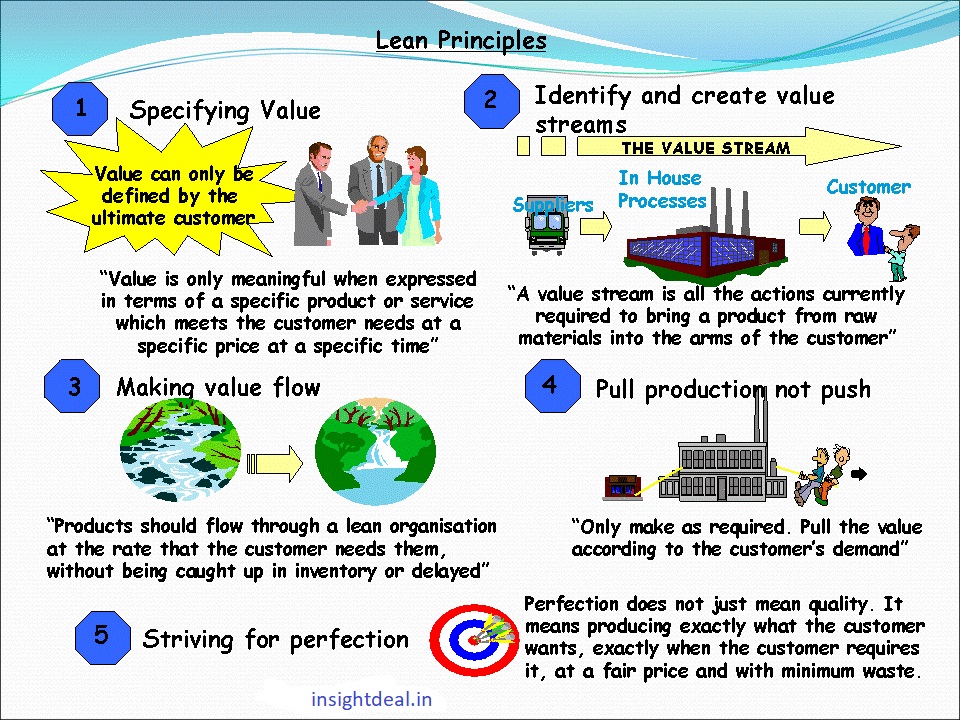Lean Methodology
Introduction to Lean
Many companies today have been around for several decades or more. When these companies were started, they implemented processes that worked then and for the most part, still, work today. They keep doing things the same way without change simply because they have always done it that way, the “don’t fix it if it is not broken” principle. The problem is that the business world isn’t the same as it was a few decades ago. With recent advances in technology and communication came changes in the way we do business.
Today we do business in a world market and parts and supplies are commonly sourced from around the world. The business competition just keeps increasing. Companies must look for ways to reduce waste and improve product quality to remain competitive. Lean methodology is very effective at eliminating and reducing waste. Many organizations from manufacturing to healthcare have successfully implemented Lean methodology. They have benefited through increased productivity, elimination of waste, and improved quality resulting in a positive impact on the bottom line. Regrettably, many organizations have yet to discover the value of Lean methodology.

What is Lean
Lean is the act of reducing waste and adding customer-defined value to products and services. The definition of Lean tends to vary slightly depending upon the source, nevertheless, the underlying meaning is the same. In the United States, the predominant thought is that Lean is a system of tools and techniques for reducing waste and adding value in every process. In Japan, Lean is considered a mindset and not a set of tools. The fundamental principles of Lean methodology are based on eliminating all forms of waste and increasing customer perceived value with everything we do. Also, management must support and encourage the Lean mindset throughout the organization at all levels. Lean means doing more with less while doing it better.
Why Implement Lean
Organizations today must do more with less. Many companies are continually looking for ways to become more competitive in the marketplace. Every new product idea must have a solid business case to back it up. Otherwise, management would not allow that project to continue. On several occasions, the fate of a project has rested upon cost versus market value. Lean is all about adding value to the product while eliminating waste. Is it possible that hidden waste is driving up the cost of your products and services? To assure long-term survival in today’s economy, organizations must continually reduce waste. Lean helps identify eight types of waste:
- Motion: Unnecessary motion of personnel, equipment, or information due to inadequate workspace layout, missing parts or tools, and ergonomic issues
- Transportation: Transporting items or information that is not required to perform the process from one location to another
- Waiting: Time waiting for parts, tools, supplies, or the previous process step
- Overproduction: Producing more product than what is required to meet current demand
- Defects: Non-conforming products or services requiring resources to correct
- Inventory: Inventory or information that is being stored or not being processed likely due to line imbalance or overproduction
- Unrecognized talent: Failure to effectively engage employees in the process and fully utilize their knowledge and skills
- Extra processing: Activity that is not adding value or required to produce a functioning part, product, or service

By continually identifying and eliminating waste in our processes, we can lower costs and increase margin. Lean, done properly, enables an organization to be more adaptable to changes in the market and the economy. To quote the words of W. Edwards Deming, “No one has to change. Survival is optional.” Through the implementation of Lean, organizations will benefit from streamlined processes, reduced waste, and lower manufacturing costs. In addition, the development of a continuous improvement company culture is also an outcome of Lean. These organizations will not merely survive; these organizations will grow and given that, create additional jobs.
How to Implement Lean
Commitment to Succeed
There are certain steps involved in the implementation of Lean and various tools utilized within the Lean methodology. Although, before any improvement activities occur the Lean initiative must have the full support of management. There must be a commitment from management to provide the proper resources and on-going support to implement a Lean program that will stand the test of time. Companies will at times organize one “Lean Event” and initiate 5S, congratulate themselves, and stop supporting the initiative. At the heart of Lean is gradual continuous improvement or Kaizen. An organization cannot expect to implement Lean overnight. It will require time, resources, and hard work to build a robust and effective Lean program.
Employee Training
One very important thing you must consider is training and education for your teams. Every professional sports team receives rigorous and continuous training to refine their skill-sets and coaching to keep them motivated and on track towards success. Proper training in Lean methodology and all the tools, along with regular guidance and encouragement, will greatly improve your team’s chance of success and provide for a smoother transition towards a Lean culture.
Identifying Waste
Waste exists in almost every process in one form or another. No matter how efficient your process currently is, it most likely can be improved. Any step or operation that does not add value is a waste. One method used to discover waste is the Value Stream Map. The Value Stream Map depicts how materials, parts, and processes flow through the organization and on to the customer. Also, the map should identify how different actions and departments are interconnected. Through an examination of the map, your team can identify which actions and processes add value and which are wastes. The team can then develop a “future state” map with as many of the non-value-added actions and processes excluded. As you develop the new value stream, look for ways to change to a pull system where production is based on customer demand and eliminate the waste.
Determining Root Cause
For each of the wastes identified using the Value Stream Map, the team should determine the root cause. Root Cause Analysis (RCA) is often performed through brainstorming and the use of a fishbone or cause and effect diagram. Once the most likely causes are identified the team could then perform a 5 Why exercise and determine the root cause.
Taking Action
Once the root causes for each waste have been determined, the team should put together an action plan. The actions should take into account any effects on the rest of the process. Anytime we make a change, new content is introduced into the process. Unknown content is process risk and can be evaluated by Failure Mode and Effects Analysis (FMEA).
Tools for Reducing Waste
5S
When 5S is implemented properly, it can identify and reduce many forms of waste in any process or workstation. An organized work area reduces excessive motion and wasted time looking for the right tool. The visual aspect of the 5S methodology is also very effective. When everything has a place, waste in the form of looking for tools or supplies is eliminated. Improved visual controls are implemented as part of 5S to make any process non-conformances obvious and easily detectable.
The 5S list is as follows:

- Seiri / Sort – Separating the essential from the nonessential items
- Seiton / Straighten – Organizing the essential materials, everything has its place
- Seiso / Shine – Cleaning the work area
- Seiketsu / Standardize – Establishing a system to maintain and make 5S a habit
- Shitsuke / Sustain – Establishing a safe and sanitary work environment
JIT
Just in Time (JIT) manufacturing is a core component of Lean methodology. JIT manufacturing seeks to eliminate waste in the form of overproduction and excess inventory. The key principles of JIT manufacturing are as follows:
- Minimize stock and resources and purchase materials and ship products only when required
- Eliminate waste in the form of excess inventory
- Produce smaller batches based on the actual demand allowing production to operate smoothly and balanced
- Reduce waste in form of WIP
- Smaller batches allow for improved quality monitoring and ease of quarantine for any non-conforming material
Kanban
Kanban is a Japanese term for a visual signal or card. Kanban works hand in hand with JIT when used to regulate production batches of parts and their delivery to the production line. In many cases, Kanban cards are used to signal the need for replenishment of component parts or supplies. When an operator or material handler pulls a set quantity of parts, the corresponding Kanban card is returned to the work cell or area producing or supplying the parts. The quantity of parts listed on the card is indicated by a color code tag and that amount is produced. In so doing, the required amount of parts is constantly available without the waste of excess inventory or work in process.
Mistake Proofing
Mistake Proofing focuses on reducing wasted production time, rework, and increased scrap. Reducing or eliminating errors in a process can be achieved by either adding more detection controls (additional inspections, special tools, expensive test equipment) or through the implementation of preventive controls. The goal is to make it impossible for the error to occur. See the following options for addressing potential errors:
- Simplify the step by making the correct action simpler to perform than the error
- Eliminating the step by asking, is this step required, and does it add value
- Error Proofing the step, making it impossible to create error
BLACKSMITH
Implementing SMED (Single Minute Exchange of Die) methods greatly reduces the amount of machine downtime for tool changes. Reducing changeover or set-up times allows for increased machine uptime and improves process efficiency. Equipment changeovers consist of two types of operations or elements:
- Internal Elements – Steps performed when equipment is not running
- External Elements – Steps performed when equipment is running
The goal of SMED is to enable the operator to perform as many changeover steps as possible while the equipment is running and streamline the remaining steps. By implementing a robust SMED program, you can realize the following benefits:
- Improved efficiency through increased machine uptime
- Permits the running of smaller lot sizes (supports JIT)
- Improved responsiveness to demand (supports “pull” system)
- Lower inventory levels (smaller lot sizes, eliminates excess inventory waste)
Kaizen
Kaizen is a key building block for a robust sustainable Lean initiative. The goal of Kaizen is to improve productivity, reduce waste, eliminate unnecessary hard work and humanize the workplace. Kaizen is not a specific tool or set of tools to improve quality. Kaizen is more than a destination, it is a journey. Kaizen philosophy empowers everyone to assume responsibility for their work processes and improve them. With Kaizen, workers at all levels of the organization are engaged in constantly watching for and identifying opportunities for change and improvement. Kaizen is a culture change that supports gradual continuous improvement daily. When everyone is working to reduce waste and improve processes the organization becomes Lean.
Through proper planning, education, and application of the Lean tools, processes can be optimized and waste eliminated. Also, participation in the improvement activities tends to build employee morale. When the workers are involved in the improvements they tend to feel more ownership of their processes. When this occurs you can build towards a gradual continuous improvement culture. Rather than making large expensive changes that can be disruptive to the workplace, you will begin making smaller sustainable changes. The application of Lean methodology is achieving measurable results across all types of industries. The lean methodology helps you reduce costs while delivering added value to your customers.

